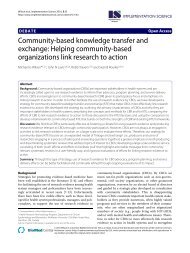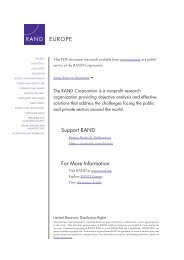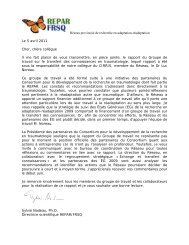Promoting and Embedding Innovation
Promoting and Embedding Innovation
Promoting and Embedding Innovation
You also want an ePaper? Increase the reach of your titles
YUMPU automatically turns print PDFs into web optimized ePapers that Google loves.
Evaluation<br />
The research suggests that however<br />
imperfectly applied, it is imperative to<br />
incorporate evaluation into the ongoing<br />
process of innovation diffusion <strong>and</strong><br />
routinisation (Chapman et al, 2004). The<br />
implementation aspect of innovation makes it<br />
unsuitable for experimental evaluation design<br />
(Booth & Falzon, 2001). When measuring<br />
inputs <strong>and</strong> outputs of innovations, the former<br />
are likely to include quantifiable financial,<br />
human <strong>and</strong> physical resources alongside the<br />
more difficult to measure tacit knowledge<br />
(Adams et al, 2006). In order to capture the<br />
range of individual, group <strong>and</strong> organisational<br />
level processes <strong>and</strong> outcomes a combination<br />
of approaches might be adopted. For<br />
example, qualitative individual reflections,<br />
evaluation of group process through „action<br />
research‟ <strong>and</strong> quality assurance in relation to<br />
organisational processes (Booth & Falzon,<br />
2001). Crucially, evaluation should not be<br />
confined to the pilot or early introduction phase<br />
at the expense of ongoing evaluation of<br />
processes <strong>and</strong> outcomes.<br />
Freeman et al, (2006) suggest that<br />
evaluation objectives should include:<br />
o Extent of fit between the innovation<br />
<strong>and</strong> context<br />
o Stakeholder perceptions <strong>and</strong><br />
experiences of the innovation<br />
o Extent of change to services <strong>and</strong><br />
outcomes<br />
o Extent to which new practices have<br />
become embedded<br />
o The effects (<strong>and</strong> unintended<br />
consequences) of the innovation on<br />
services, services users, <strong>and</strong> the<br />
wider system<br />
o Learning that can be transferred to<br />
other settings <strong>and</strong> how this relates to<br />
the broader literature on innovation<br />
Issues to bear in mind when drawing up a list<br />
of outcome measures include not just benefits<br />
to the organisation <strong>and</strong> patients, but also the<br />
distribution of positive net benefits, for<br />
example between organisations, functions <strong>and</strong><br />
user groups (Coyte & Holmes 2007, Rye &<br />
Kimberly 2007). Authors caution against<br />
„reverse access‟ problems where for example<br />
disadvantaged groups continue to access less<br />
effective or harmful innovations (Rye &<br />
Kimberly, 2007). Ultimately, outcome<br />
measures should reflect the underlying<br />
objectives of the innovation process<br />
(Dickinson, 2008) <strong>and</strong> measures should be<br />
carefully screened according to<br />
appropriateness <strong>and</strong> relevance (Kimberly &<br />
Cook, 2008).<br />
Health Services Management Centre 35
















